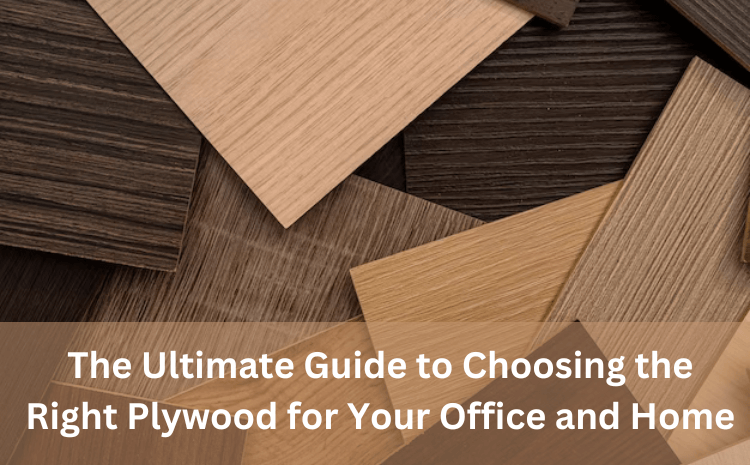Consider for a moment one of the most crucial elements of any interior design project. Is it the woodwork, the placement of the furniture, the type of paint, or all three? Even though they all improve the look and quality of your property, woodwork is undeniably the most important. After all, wood, primarily plywood, is what those posh TV cabinets, the modern modular kitchen, the expertly manufactured sofa, bed, wardrobe, and everything else are made of. But do you comprehend the several varieties of plywood shown to you by the plywood manufacturers in Jaipur? Additionally, you could have overheard designers and contractors discussing the variable pricing of various plywoods. Why is this the case? Most importantly, do you know which type of plywood will work best for whatever application?
Now that we have all of your questions answered, let’s move ahead.

Describe plywood
The standard composition of plywood is thin wood veneers (plies) that have been stripped from logs and sandwiched with binders before being heated and pressed. The plies are placed out at various angles, causing the grain to run in one direction on the first layer, the next direction on the second layer, and so on.
since of the alternating layers, plywood is more dimensionally stable than a typical 24 since it doesn’t expand and contract with moisture along the grain. Plywood is resistant to warping, bending, cracking, breaking, and shrinking due to its composition and components. The least number of plies is three, and more plies are often preferable.
The Different Plywood Types Based on the Wood Used
Continue reading to get easy, lucid solutions to all of your plywood-related queries.
1. Hardwood
Typically, Birch, Gurjan, or Teakwood are used to make this sort of plywood. They are pricey and frequently labeled as being made entirely of hardwood. This is the sort of plywood you would like to get for your interiors if you’re seeking something that is wholly unique and has no spending restrictions.
In India, gurjan wood is mostly employed. When it comes to high-quality ply, it is likewise regarded as one of the greatest possibilities. Natural wood with a reddish tint is what gives hardwood plywood its characteristic identity. Additionally, the ply is the best option for heavy-duty floor and wall structures due to its excellent strength, stiffness, and great impact resistance.
2. Softwood
Choose softwood plywood if you want a product that is less expensive than hardwood. These plays are sold by plywood suppliers in Jaipur and are often made of mango or Spruce-Pine-Fir (SPF) wood. When compared to hardwood plywood, softwood plywood is a less expensive choice. But keep in mind that it isn’t as robust as hardwood plywood.
Softwood plywood has a somewhat yellowish tint, which makes it easy to recognize.
3. Poplar Ply
If you’re searching for a plywood that falls between hardwood and softwood, Poplar Ply is your best bet. This kind of plywood, which is also known as “Soft Hardwood,” is moisture-resistant and has excellent bending strength and durability. It is known as soft hardwood because, among hardwood plys, it has the least “hardness.”
Due to its incredible moisture resistance, poplar plywood is the finest choice for humid environments. The ply is very lightweight, making it the ideal material for interior structures with high ceilings.
4. Alternate Core plywood
You might be perplexed by the unusual name of this plywood, but there’s a good explanation behind it. The Alternate Core plywood is really a blend of woods with red and yellow tones. As a result, the plywood’s cross-section alternates between yellow and red wood cores. This ply is hence referred to as “Alternate Core.”
Typically, plywood manufacturers in Jaipur use this plywood to create a well-balanced product that is more resilient than softwood plays and less expensive than pure hardwood ones. So, this is a possibility to think about if you want the strength of hardwood plywood but aren’t prepared to pay a lot for it.
The majority of home furnishings will match perfectly with these varieties of plywood.

Grades of plywood
The plywood’s outside look is what is meant by the grade.
- Grade A: The sheet’s face and back are essentially defect-free, with a smooth, sanded surface and few to no knots. The surface is suitable for cabinet doors and furniture, may be stained or painted, and is designed to be seen rather than covered with another material.
- Grade B: The face and back have various imperfections, some of which have been fixed with patches or wood filler, but they have been sanded smooth. cheaper than Grade A.
- Grade C: tight knots up to 1 12 inches broad, unsanded. There might have been extensive filling and patching. Excellent for subflooring or other oblique applications.
- Grade D: Unsanded, with knot holes up to 2 12 inches wide, a lot of filler and patches, and other flaws that haven’t been fixed. Similar to Grade C, suitable for structural applications where it won’t be visible.
When two grades are listed, such as in the example A/B, the A stands for the front and the B for the back.
Sizes of Plywood
The three major sizes of plywood panels made by plywood manufacturers in Jaipur are:
4 ft. x 8 ft.
4 ft. x 9 ft.
4 ft by 4 ft.
The project’s requirements will determine the thickness of the plywood you select. Plywood comes in a bewildering variety of sizes and varieties. Plywood typically ranges in thickness from 1/8 inch to more than 1 12 inches. The majority of plywood in a large box retailer will be 1-inch, 34-inch, and 2-inch thick.
For use as an underlayment between subflooring and tile, very thin plywood is suitable. On a new shed, however, structural sheathing linked to the frame elements or the actual flooring requires stronger plywood. Building regulations must be obeyed.
CONCLUSION
It’s better to know what you need before going to the house remodeling store or the plywood shop in Jaipur.

